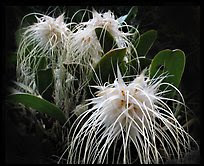Orchids beguile in a variety of ways to attract pollinators. Their ploys seduce, attract, and hoodwink their prey. They imitate fragrances and also present unpleasant odors while pulsing their landing platforms. Orchids mimic enemies, sexual partners, and phony nests.
The deceptions become a diversion for only the orchids' benefit. Promises of reward serve only to get the flowers fertilized. The pollinator gets nothing in return.
In 1862, Charles Darwin felt a fascination for orchids and studied the orchid's seductive process. He published, On the Various Contrivances by Which British and Foreign Orchids Are Fertilized by Insects. The book became a best seller before the publication of his Origin of Species.
Orchids display their attractiveness even in the Arctic Circle. More orchid species exist
(26,000 -30,000) than species of mammals, reptiles, and birds combined.
Orchids (family Orchidaceae) provide sticky packets of pollen to entice bees and wasps that do the most work. Also flies, butterflies, moths, and birds get seduced by the process. Mosquitoes, ants, beetles, and small animals feel attracted by the orchid's siren call.
Reciprocity does occur. Even though the pollinators receive no reward, those of us who love the colors, shapes, and scents do benefit from the whimsy of orchids.






No comments:
Post a Comment